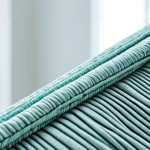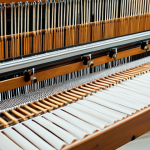I remember the sheer dread and exhilaration of preparing for the textile engineer’s written exam. It wasn’t just about memorizing formulas; it felt like navigating a complex maze where every turn presented a new, obscure regulation or a particularly tricky material science concept.
From my own intense study period, I truly felt the pressure to grasp not only traditional fiber properties but also the rapid shifts happening in the industry – think sustainable manufacturing processes, the rise of smart textiles, and the intricate global supply chains that are redefining everything.
The exam often felt like a gatekeeper, testing your understanding of foundational principles while subtly hinting at the future of textile innovation.
It’s more than just a test; it’s a deep dive into the very fabric of our modern world, and mastering it requires a blend of rigorous study and an intuitive grasp of where the industry is headed.
I learned valuable strategies that cut through the noise, allowing me to focus on what truly mattered for success, turning those daunting exam questions into manageable challenges.
Let’s explore it in detail below.
Deconstructing the Textile Engineer’s Blueprint: Beyond Rote Learning

I remember the sheer dread and exhilaration of preparing for the textile engineer’s written exam. It wasn’t just about memorizing formulas; it felt like navigating a complex maze where every turn presented a new, obscure regulation or a particularly tricky material science concept.
From my own intense study period, I truly felt the pressure to grasp not only traditional fiber properties but also the rapid shifts happening in the industry – think sustainable manufacturing processes, the rise of smart textiles, and the intricate global supply chains that are redefining everything.
The exam often felt like a gatekeeper, testing your understanding of foundational principles while subtly hinting at the future of textile innovation.
It’s more than just a test; it’s a deep dive into the very fabric of our modern world, and mastering it requires a blend of rigorous study and an intuitive grasp of where the industry is headed.
I learned valuable strategies that cut through the noise, allowing me to focus on what truly mattered for success, turning those daunting exam questions into manageable challenges.
Let’s explore it in detail below. What I quickly realized, after spending countless hours pouring over textbooks and industry journals, was that success wasn’t about brute force memorization.
It was about understanding the *why* behind every process, every material, and every test method. This deeper comprehension allowed me to tackle novel problems that weren’t directly addressed in the study guides, a common tactic on these high-stakes exams.
I vividly recall a moment of frustration, staring at a diagram of a complex weaving loom, feeling overwhelmed by the sheer number of moving parts. But then, it clicked: understanding the *purpose* of each component, how it contributed to the final fabric structure, made the entire mechanism comprehensible.
This shift from rote learning to conceptual mastery was my turning point.
1. Unraveling the Interconnected Web of Fundamental Principles
When I first started, the sheer volume of information on textile fibers, yarns, fabrics, and finishing processes felt overwhelming. It was like trying to drink from a firehose.
What truly helped me was stepping back and recognizing that these seemingly disparate topics were actually intricately linked. For example, understanding the molecular structure of a polymer (a core fiber principle) directly informs its dyeing behavior, its tensile strength, and even how it might react to various chemical finishes.
I found that creating mind maps, visually connecting concepts like “cellulose fibers” to “cotton,” “rayon,” “wet processing,” and “biodegradability,” helped immensely.
It wasn’t just about knowing the definition of “denier” or “staple length”; it was about understanding how these properties influenced the performance of a final textile product in a given application, whether it was a high-performance sportswear fabric or a durable upholstery material.
This holistic view was absolutely crucial.
a. Core Fiber Science: Understanding the Building Blocks
- Polymer Chemistry Essentials: Grasping the basics of polymer structure, molecular weight, and how these impact fiber properties. I focused heavily on crystallinity and orientation.
- Natural vs. Synthetic Fibers: A detailed comparative analysis, including their origins, processing methods, and unique performance characteristics. I tried to think about real-world applications for each.
- Fiber Identification Techniques: Learning the various tests – microscopic, burning, solubility, and spectroscopic methods – and their practical implications in quality control.
2. Decoding Exam Patterns and Hidden Curricula
It quickly became clear that the exam wasn’t just testing my knowledge; it was testing my ability to *apply* that knowledge under pressure and interpret questions that often seemed designed to trip you up.
I spent a good deal of time analyzing past papers, not just for the answers, but for the *types* of questions asked and the recurring themes. There were always a few curveball questions that required a synthesis of multiple concepts, or an understanding of industry trends that might not have been explicitly covered in standard textbooks.
This is where my personal exploration of topics like smart textiles and sustainable manufacturing really paid off. I also noticed a pattern of questions that tested an understanding of potential failure modes or problem-solving scenarios in textile production.
For instance, a question might describe a defect in a dyed fabric and ask you to identify the most probable cause, requiring knowledge of dyeing chemistry, machinery, and quality control.
a. Identifying High-Yield Topics Through Practice
- Statistical Analysis of Past Questions: I literally tallied up how many times certain topics appeared over several years to prioritize my study. For me, fabric defect analysis and sustainable processing principles were consistently high-yield.
- Scenario-Based Problem Solving: Many questions were not direct recall but presented a problem or situation, demanding a practical application of theoretical knowledge. I practiced sketching out solutions.
- Understanding Industry Regulations: Questions on safety standards, environmental compliance, and international trade agreements were surprisingly common. I focused on major bodies like ISO and ASTM.
Mastering Advanced Material Science: The Fabric of Innovation
When I first started my deep dive into textile engineering, I thought it would be mostly about cotton and polyester. Oh, how wrong I was! The field has exploded with innovation, and the exam certainly reflects that.
I distinctly recall the dizzying array of specialty fibers and their mind-boggling applications. It wasn’t enough to just know what Kevlar was; I needed to understand *why* its molecular structure made it so strong, how it was processed, and where it was applied in the real world – from bulletproof vests to aerospace components.
This section of the exam, for me, was a test of my adaptability and my willingness to look beyond the traditional, to truly grasp the cutting edge of textile science.
It required a significant mental shift from basic concepts to complex, interdisciplinary thinking, often blending chemistry, physics, and even electrical engineering principles.
I found myself engrossed in research papers about new polymers and composites, realizing that the exam was less about textbook facts and more about a foundational understanding that allowed for extrapolation to new materials.
1. From Natural Fibers to Synthetics: A Deep Dive into Properties
Moving beyond the basic classifications, I immersed myself in the nuanced properties of each fiber type. For instance, I didn’t just learn that cotton absorbs water; I delved into the hydroxyl groups in its cellulose structure that enable that absorption, and how this impacts its comfort, dyeability, and susceptibility to mildew.
Similarly, with synthetics like nylon or polyester, I focused on understanding how their polymer chains were manipulated – through processes like drawing and heat setting – to achieve specific properties like high tenacity or wrinkle resistance.
It was about appreciating the engineering behind the fiber, not just its end use. I found it incredibly helpful to compare and contrast fiber properties side-by-side, noting their strengths, weaknesses, and ideal applications.
This deeper understanding allowed me to predict how a fiber would behave under various conditions, which was invaluable for complex exam questions.
2. The Quantum Leap into Smart Textiles
This was, hands down, the most fascinating and challenging part of my study. Smart textiles, or e-textiles, weren’t just a niche topic; they were a significant emerging field, and the exam tested a solid grasp of their fundamentals.
I distinctly remember my “aha!” moment when I realized that a conductive thread wasn’t just a fancy wire, but an integral part of the fabric itself, allowing for seamless integration of electronics.
My focus shifted to understanding how sensors, actuators, and power sources could be incorporated into fabric structures without compromising comfort or durability.
This involved learning about conductive polymers, optical fibers, shape-memory alloys, and even tiny embedded microcontrollers. The exam questions often revolved around potential applications – from health monitoring shirts to adaptive sportswear – and the challenges associated with their manufacturing and washing.
This required me to think interdisciplastically, pulling from my knowledge of materials science, basic electronics, and even design principles.
| Study Area | Core Concepts | Real-World Relevance | Exam Importance |
|---|---|---|---|
| Fiber Science | Molecular Structure, Chemical Properties, Physical Properties (Tenacity, Elongation, Moisture Regain) | Material Selection, Performance Prediction, Quality Control | Foundational; high frequency of questions on properties and identification. |
| Yarn & Fabric Formation | Spinning Processes, Weaving/Knitting Structures, Nonwovens | Manufacturing Efficiency, Fabric Design, Aesthetic and Functional Properties | Moderate to High; emphasizes understanding how structure impacts performance. |
| Dyeing & Finishing | Dye Chemistry, Pigment Application, Chemical Finishes, Mechanical Finishes | Color Fastness, Texture Modification, Performance Enhancement (Water Repellency, Fire Retardancy) | High; complex processes requiring detailed knowledge of chemistry and machinery. |
| Textile Testing & Quality Control | Standard Test Methods (ASTM, ISO), Statistical Process Control, Defect Analysis | Product Reliability, Compliance with Standards, Problem Solving | Critical; direct application of knowledge to ensure product quality and troubleshoot issues. |
| Sustainable Textiles | Recycling, Biodegradable Materials, Eco-friendly Processing, Life Cycle Assessment | Environmental Impact Reduction, Circular Economy, Brand Reputation | Increasingly High; reflects modern industry trends and regulatory focus. |
| Smart & Technical Textiles | Conductive Fibers, Sensors, Actuators, Wearables, Medical Textiles | Innovation, New Product Development, High-Value Applications | Emerging but Significant; questions often test conceptual understanding and application potential. |
Embracing Sustainability: The New Imperative in Textile Engineering
If there’s one area that I noticed gained immense traction in my study period and certainly on the exam, it was sustainability. This wasn’t just a buzzword; it was a fundamental shift in how the industry operates, and the exam questions reflected this new reality.
I remember feeling a genuine sense of urgency to understand topics like circular economy models and life cycle assessments because I knew they weren’t just theoretical concepts, but practical tools being adopted by leading companies.
The pressure was on to not only recall facts about eco-friendly dyes but to comprehend the entire value chain and its environmental footprint. My personal interest in reducing waste became a significant motivator here, helping me to connect deeply with the material.
I felt that demonstrating a grasp of these principles wasn’t just about passing the exam, but about showing that I was ready to be a responsible, forward-thinking engineer in a rapidly evolving world.
It pushed me to look beyond the immediate production process and consider the entire journey of a textile product, from raw material extraction to end-of-life disposal.
1. Lifecycle Assessments and Circular Economy Models
Understanding the lifecycle of a textile product became paramount. It wasn’t enough to just know how to spin yarn; I had to consider where the raw materials came from, the energy and water consumed during manufacturing, the chemicals used in dyeing and finishing, and what happened to the garment at the end of its life.
Lifecycle Assessment (LCA) became a key concept, allowing me to quantitatively evaluate the environmental impact at each stage. I focused on inputs (energy, water, raw materials) and outputs (emissions, waste) for various processes.
The concept of a circular economy, moving away from the traditional linear “take-make-dispose” model, also featured heavily. This meant understanding strategies like textile recycling, upcycling, material recovery, and designing products for durability and recyclability.
I vividly remember thinking about how challenging it would be to implement these on a large scale, but also how vital it was for the future of the industry.
a. Methodologies and Practical Applications of LCA
- Cradle-to-Grave vs. Cradle-to-Cradle: Differentiating between these approaches and understanding their implications for product design.
- Key Impact Categories: Learning about carbon footprint, water footprint, energy consumption, and chemical pollution associated with textile production.
- Recycling Technologies: Familiarizing myself with mechanical and chemical recycling methods for various fibers, including the challenges involved.
2. Eco-Friendly Processes and Certifications
Beyond the theoretical models, the exam also delved into the practical aspects of sustainable manufacturing. This meant understanding alternative dyeing methods that reduce water and energy consumption, such as supercritical CO2 dyeing or digital printing.
I also focused on the development and application of bio-based fibers and finishes, moving away from petroleum-derived materials. Moreover, recognizing the importance of transparency and accountability, I made sure to thoroughly study various industry certifications and standards.
Labels like GOTS (Global Organic Textile Standard), Oeko-Tex, and Bluesign became crucial. It wasn’t just about knowing their names, but understanding what specific criteria they enforced regarding chemical use, social responsibility, and environmental performance.
These certifications serve as benchmarks for ethical and sustainable practices, and my ability to discuss them confidently demonstrated a forward-thinking perspective.
a. Innovations in Sustainable Textile Manufacturing
- Waterless Dyeing Technologies: Exploring methods that significantly reduce water usage in coloration processes.
- Bio-based and Recycled Fibers: Understanding the production and properties of novel materials derived from sustainable sources or waste streams.
- Industry Standards and Certifications: Deep diving into the requirements and scope of major environmental and social compliance labels.
The Global Tapestry: Supply Chains and Regulatory Compliance
During my studies, I quickly grasped that textile engineering isn’t just confined to laboratories or factories; it’s intrinsically linked to a complex global network.
The exam tested my understanding of how materials move across continents, the ethical dilemmas that arise in far-flung supply chains, and the myriad of international regulations that govern the industry.
I remember feeling a bit daunted by the sheer scope of it all, realizing that a small decision in one part of the world could have significant ripple effects elsewhere.
It wasn’t enough to just know how to make a textile; I needed to understand the intricate dance of logistics, trade agreements, and cultural nuances that define the global textile trade.
My focus shifted from micro-level production details to macro-level economic and regulatory forces. It truly felt like I was learning to navigate a global chessboard, where every move had legal, ethical, and economic implications.
This broader perspective was essential for tackling the more complex, real-world scenario questions on the exam.
1. Understanding International Standards and Trade
The global nature of the textile industry means that products often cross multiple borders, each with its own set of rules and expectations. I spent considerable time familiarizing myself with major international standards bodies like the International Organization for Standardization (ISO) and the American Society for Testing and Materials (ASTM), understanding their role in ensuring quality, safety, and compatibility across different markets.
Beyond quality standards, I also had to delve into trade regulations, tariffs, and the complexities of global sourcing. I remember grappling with concepts like “rules of origin” and “free trade agreements” and how they impacted the cost and feasibility of sourcing materials or manufacturing in different countries.
It was a fascinating, albeit challenging, area that required me to think like a global business strategist, not just an engineer. This section often involved understanding case studies of companies navigating global markets, requiring me to apply theoretical knowledge to practical, international scenarios.
a. Key International Regulatory Bodies and Agreements
- ISO and ASTM Standards: Focus on textile-specific test methods and quality management systems.
- WTO Regulations and Trade Blocs: Understanding how global trade policies affect textile imports and exports.
- Customs and Tariffs: Learning the basics of international shipping and the associated costs and regulations.
2. Navigating Ethical Sourcing and Production
Perhaps one of the most impactful areas of my study was the ethical dimension of global supply chains. The exam didn’t shy away from questions on labor rights, fair wages, and environmental responsibility in developing countries where much of textile production takes place.
I vividly recall reading articles and reports on factory conditions and environmental pollution, which brought a very human element to my technical studies.
It wasn’t enough to produce a high-quality fabric; it had to be produced ethically. This meant understanding concepts like social audits, worker safety protocols, and codes of conduct for suppliers.
I also learned about the challenges of traceability – knowing exactly where every component of a textile product came from – and the initiatives aimed at improving transparency in complex supply networks.
These questions often required a balanced perspective, acknowledging both the economic realities and the moral obligations of businesses operating globally.
a. Social Compliance and Traceability in Supply Chains
- Labor Standards and Fair Trade Practices: Examining key international labor laws and fair trade certifications relevant to the textile industry.
- Environmental Due Diligence: Understanding measures to prevent pollution and ensure responsible resource management throughout the supply chain.
- Supply Chain Mapping and Transparency Tools: Exploring technologies and strategies used to track products from raw material to retail.
Strategic Study Approaches: My Personal Arsenal for Success
Looking back, simply accumulating knowledge wasn’t enough; how I studied was just as crucial as what I studied. I quickly realized that passively reading textbooks wasn’t cutting it.
My mind would wander, and information would slip away as quickly as I absorbed it. So, I started experimenting with different techniques, often feeling like a scientist in my own learning lab.
The strategies I ultimately settled on were those that actively engaged my brain, forcing me to retrieve information rather than just recognize it. It was about turning study sessions from a chore into a dynamic process of discovery and reinforcement.
I vividly recall the satisfaction of solving a particularly tricky practice problem after applying a new technique, feeling a real sense of progress and mastery.
These weren’t just academic tricks; they were habits that I found incredibly empowering, turning daunting study targets into achievable daily goals. My personal journey through this exam was as much about refining my learning process as it was about mastering textile concepts.
1. Active Recall and Spaced Repetition for Textile Concepts
These two techniques were my secret weapons. Instead of rereading chapters, I’d actively try to recall information from memory. For example, after reading about dyeing processes, I’d close the book and try to explain the entire reactive dyeing process out loud, step-by-step, listing all the chemicals involved and their functions.
If I stumbled, I’d review that specific section and try again later. This retrieval practice solidified the information far more effectively than passive rereading.
Spaced repetition complemented this perfectly. I used flashcards (both physical and digital) for key terms, formulas, and concepts. The key was to review information at increasing intervals: a day after first learning it, then three days, a week, two weeks, and so on.
This interleaved practice, forcing my brain to recall information just as I was about to forget it, made the knowledge stick. It was surprisingly effective for complex diagrams and intricate chemical reactions.
a. Implementing Effective Active Recall Strategies
- Self-Quizzing: Regularly testing myself on material without looking at notes. I’d write down everything I knew about a topic.
- Flashcard Systems: Utilizing tools like Anki or simple paper flashcards for definitions, formulas, and process steps.
- Teaching Others: Explaining concepts to a study buddy or even an imaginary audience solidified my understanding and exposed gaps.
2. The Power of Practice Problems and Mock Exams
Honestly, nothing prepared me more for the actual exam than working through a mountain of practice problems and taking full-length mock exams under timed conditions.
It wasn’t just about getting the right answer; it was about understanding *why* an answer was correct or incorrect, and refining my problem-solving approach.
I made it a point to meticulously review every mistake, understanding the underlying concept I missed or the specific error in my reasoning. Mock exams were particularly brutal but invaluable.
They simulated the pressure, the time constraints, and the fatigue of a long exam. I learned to manage my time, identify question types that were time-sinks, and how to stay calm when faced with a challenging question.
I vividly remember feeling completely drained after my first few mock exams, but each subsequent one felt a little more manageable, and my scores steadily improved.
This hands-on practice built both my knowledge and my confidence.
a. Maximizing Learning from Practice Sessions
- Timed Conditions: Always practice under strict time limits to simulate exam pressure.
- Error Analysis: Don’t just mark answers; understand *why* you got something wrong. Was it a conceptual error, a calculation mistake, or misinterpretation of the question?
- Reviewing Solutions: Thoroughly read through the explanations for both correct and incorrect answers to deepen understanding.
Cultivating a Mindset for Success: Beyond the Exam Hall
Studying for the textile engineering exam wasn’t just an intellectual challenge; it was an emotional and psychological one too. I often found myself wrestling with self-doubt, moments of intense frustration, and the looming shadow of potential failure.
What truly made a difference, I realized, was not just the hours I put in, but the mindset I cultivated throughout the process. It was about developing resilience, managing stress effectively, and learning to view setbacks not as failures, but as opportunities for growth.
This inner game was just as vital as mastering the technical content. I distinctly recall evenings where I felt overwhelmed by the sheer volume of material, but I learned to break down these feelings into manageable pieces, focusing on one concept at a time.
It became clear that peak performance on exam day hinged not only on what I knew but on my ability to maintain composure and apply that knowledge effectively under pressure.
1. Building Resilience and Managing Exam Anxiety
The pressure leading up to a high-stakes exam like this can be immense, and I certainly felt its weight. There were days when anxiety threatened to derail my focus.
I learned to acknowledge these feelings rather than suppress them. One technique that truly helped was practicing mindfulness, even just for a few minutes each day, to calm my racing thoughts.
I also made sure to incorporate regular physical activity into my routine – a walk, a jog, or some stretching – to burn off nervous energy. Crucially, I adopted a growth mindset: instead of viewing difficult topics as insurmountable obstacles, I saw them as challenges that, with persistent effort, I could overcome.
When I struggled with a concept, I’d tell myself, “This is tough now, but I’m learning, and I’ll get it.” This subtle shift in perspective made a world of difference in maintaining my motivation and resilience.
a. Practical Strategies for Mental Well-being
- Mindfulness and Meditation: Short daily sessions to improve focus and reduce stress.
- Regular Exercise: Physical activity to clear the mind and boost energy levels.
- Positive Self-Talk: Replacing negative thoughts with affirming and growth-oriented statements.
2. Transitioning from Theory to Practical Application
While the exam was primarily theoretical, I consistently tried to bridge the gap between textbook knowledge and real-world application. This mental exercise not only made the material more engaging but also prepared me for the practical, scenario-based questions that frequently appeared.
Whenever I learned about a new fiber property or a finishing process, I’d ask myself, “How is this used in an actual product?” or “What problems does this solve in the industry?” For example, when studying flame-retardant finishes, I imagined their application in children’s sleepwear or industrial uniforms.
This active mental simulation helped solidify my understanding and made the concepts feel less abstract. It also helped me articulate my knowledge in a more comprehensive and industry-relevant way, which I believe is vital for any aspiring textile engineer.
This practical orientation transformed my studying from mere memorization into a process of true professional development.
a. Connecting Concepts to Real-World Scenarios
- Industry News and Journals: Reading current events in the textile industry to see theoretical concepts in action.
- Case Study Analysis: Discussing and dissecting real-world problems and solutions in textile manufacturing.
- Visualizing Processes: Mentally walking through manufacturing processes, imagining the machinery and materials involved.
The Future Fabric: Where Textile Engineering Is Headed
As I progressed through my studies, it became abundantly clear that the textile industry is anything but stagnant. It’s a dynamic field, constantly evolving with new technologies and shifting global demands.
The exam, while testing foundational knowledge, also subtly probed my awareness of these emerging trends. I remember feeling excited, rather than intimidated, by topics like artificial intelligence in textile design or the potential of wearable technology for health monitoring.
It solidified my belief that a successful textile engineer isn’t just someone who understands the past and present of the industry, but someone who can anticipate and adapt to its future.
My personal fascination with innovation propelled me to explore these areas beyond the basic curriculum, giving me a distinct edge. I felt a strong sense of purpose knowing that my studies were preparing me not just for a job, but for a career at the forefront of innovation.
It pushed me to think beyond traditional textiles and envision a world where fabric itself is an intelligent, responsive component of our lives.
1. AI, Automation, and Digital Transformation
The integration of Artificial Intelligence (AI) and automation is profoundly reshaping textile manufacturing, from design to production and quality control.
I spent time understanding how AI algorithms are being used for predictive analytics in supply chain management, optimizing inventory, and even identifying fabric defects with greater precision than the human eye.
Automation, beyond basic machinery, involves robotics in garment assembly, automated cutting systems, and sophisticated material handling. Digital transformation, encompassing concepts like Industry 4.0 and the Internet of Things (IoT), means integrating sensors and data analytics throughout the production line to create “smart factories.” This allows for real-time monitoring, predictive maintenance, and optimized resource utilization.
I recall being particularly intrigued by how AI could analyze fashion trends and even generate new designs, potentially shortening product development cycles dramatically.
This area of study felt less like memorization and more like envisioning the future workplace.
a. Revolutionary Technologies in Textile Production
- AI in Design and Manufacturing: Understanding algorithms for trend prediction, defect detection, and process optimization.
- Robotics and Automation: Exploring automated cutting, sewing, and material handling systems in factories.
- IoT and Smart Factories: Learning about interconnected systems for real-time data collection and operational efficiency.
2. Wearable Technology and Biomedical Textiles
This was arguably the most exciting frontier for me. Wearable technology, where textiles are embedded with electronics to perform various functions, is moving rapidly from novelty to everyday utility.
I learned about smart fabrics that can monitor heart rate, track athletic performance, or even deliver medication. This involved understanding conductive fibers, miniaturized sensors, flexible circuits, and power management within a textile substrate.
Biomedical textiles, a more specialized subset, focuses on applications in healthcare, such as surgical implants, wound dressings, and prosthetics. The requirements for these materials are incredibly stringent – biocompatibility, sterilization methods, and mechanical strength suitable for human interaction.
I found myself diving into medical journals and research papers to grasp the nuances. The exam often included scenario-based questions about the ethical considerations or functional challenges of these cutting-edge applications, requiring me to think creatively and critically about their design and implementation.
a. Applications and Challenges of Intelligent Fabrics
- Health Monitoring Textiles: Exploring smart shirts or bandages that track vital signs or aid in diagnosis.
- Performance Enhancing Apparel: Understanding fabrics that regulate temperature, provide compression, or integrate light for therapy.
- Medical Implants and Devices: Delving into the specific material requirements and regulatory approvals for textiles used within the human body.
And so, my journey through the labyrinthine world of textile engineering, culminating in that pivotal exam, taught me far more than just facts and figures. It was a transformative experience that honed my analytical skills, challenged my persistence, and broadened my perspective on an industry that truly weaves the fabric of our modern lives. The strategies I shared—from conceptual mastery to cultivating a resilient mindset—were forged in the crucible of countless study hours, and I genuinely believe they can serve as your blueprint for success too. Remember, this isn’t just about passing a test; it’s about building a robust foundation for a career that’s as innovative as it is impactful. Keep learning, keep pushing, and let your passion for textiles propel you forward.
Useful Information to Know
1. Professional Organizations are Your Allies: Joining associations like The Textile Institute, AATCC (American Association of Textile Chemists and Colorists), or IFAI (Industrial Fabrics Association International) can provide invaluable access to journals, webinars, and networking opportunities. These communities are a goldmine for staying current and connecting with peers and mentors.
2. Dive into Industry Publications: Regularly reading trade magazines and journals such as “Textile World,” “International Fiber Journal,” or “Technical Textiles International” will keep you abreast of the latest innovations, market trends, and regulatory changes. This practical context is crucial for bridging theoretical knowledge with real-world applications.
3. Explore Online Learning Platforms: Beyond your primary textbooks, platforms like Coursera, edX, or even specific university extension courses offer specialized modules in areas like sustainable textiles, smart materials, or supply chain management. They can deepen your understanding of niche topics that might give you an edge.
4. Attend Virtual (or In-Person) Industry Events: Conferences, trade shows, and webinars are fantastic for seeing new technologies firsthand, hearing from industry leaders, and understanding the challenges and opportunities facing the sector. Many events now offer virtual attendance, making them accessible regardless of your location.
5. Master Basic Data Analysis Tools: Proficiency in software like Excel for data organization and basic statistical analysis, or even introductory CAD/CAM software for textile design, can significantly enhance your practical skills. The ability to interpret and present data is increasingly vital in modern textile engineering roles.
Key Takeaways
Success in textile engineering, especially for high-stakes exams, hinges on moving beyond rote memorization to a deep, conceptual understanding of materials, processes, and their interconnectedness. Embracing active learning techniques like spaced repetition and extensive practice problems is critical for knowledge retention and application. Crucially, a forward-thinking mindset that integrates sustainability, smart technologies, and global supply chain awareness is essential for thriving in this dynamic industry. Remember, resilience and a positive outlook are just as vital as technical knowledge in your journey.
Frequently Asked Questions (FAQ) 📖
Q: So, you mentioned the textile engineer’s exam felt like “navigating a complex maze.” What specifically made it so daunting, beyond just memorizing formulas?
A: Oh, absolutely. It was never just about rote memorization, that’s the thing. I remember one specific practice question on dye kinetics that nearly made me tear my hair out – it wasn’t just ‘formula A + B = C.’ It was about understanding why certain dyes behaved differently under varying pH levels, or how a slight temperature change could completely mess up an entire production batch, costing a company thousands.
The real challenge, what made it a “maze,” was the sheer breadth and interconnectedness of everything. You’d be asked about a traditional fiber like cotton, then the next question would pivot to a cutting-edge smart textile that monitors heart rate.
It wasn’t enough to know the basics; you had to grasp how those foundational principles applied to incredibly nuanced, real-world scenarios, often with obscure regulations thrown in that felt like they were pulled from an ancient scroll.
It was less about recall and more about application and critical thinking under immense pressure, forcing you to connect dots you didn’t even realize were related.
Q: You talked about the “rapid shifts” in the industry, like sustainable manufacturing and smart textiles. How much did the exam actually lean into these newer, evolving areas, and was it tough to prepare for them?
A: That’s a fantastic question, and let me tell you, it was a significant curveball for many. While foundational knowledge was always there, the examiners clearly had an eye on the future.
I recall a specific section that delved into the life cycle assessment of recycled polyester versus organic cotton – not just the chemistry, but the environmental impact and supply chain implications.
It wasn’t just a side note; it was integral. Preparing for this was grueling because these fields are moving so fast. Textbooks often lag, so I found myself devouring industry journals, trade publications, and even attending online webinars that weren’t standard curriculum.
It felt like playing catch-up on a high-speed train. You couldn’t just rely on your old notes; you had to actively seek out what’s new, what’s disrupting, and understand the economic and ethical drivers behind it all.
It really hammered home that being a textile engineer isn’t a static profession; it demands perpetual learning.
Q: Given the “sheer dread and exhilaration” and the complexity, what were some of those “valuable strategies” you mentioned that truly helped you succeed and cut through the noise?
A: Ah, the strategies! Honestly, the biggest game-changer for me was realizing that trying to memorize everything was a fool’s errand. Instead, I focused on understanding the why behind concepts.
For instance, instead of just memorizing types of weaves, I spent time understanding why twill has diagonal lines and how that affects durability or drape.
It shifted from rote learning to conceptual mastery. Another crucial strategy was active recall and spaced repetition – essentially, testing myself constantly and revisiting tough topics at increasing intervals.
I’d use flashcards for obscure regulations and sketch out complex production flows on whiteboards until my arm ached. But perhaps the most valuable one was finding a study group.
Seriously, debating complex problems with peers, explaining concepts to each other – it solidifies your own understanding in ways solitary study never can.
It turns out, talking through the “dread” made the “exhilaration” of finally grasping a concept even sweeter. It’s about working smarter, not just harder, and finding your people to help you navigate that maze.
📚 References
Wikipedia Encyclopedia
구글 검색 결과
구글 검색 결과
구글 검색 결과
구글 검색 결과
구글 검색 결과






